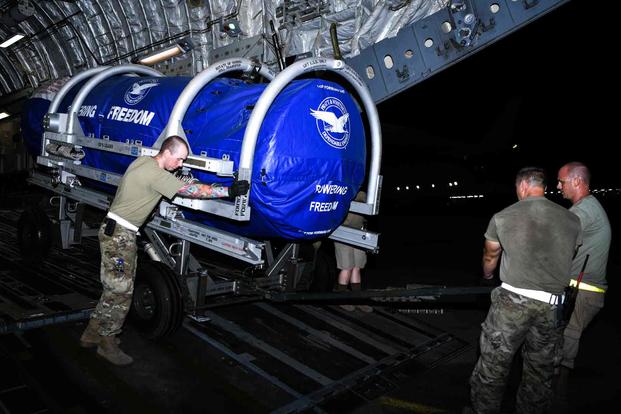The Pentagon is one step closer to being able to deliver new F-35 Lightning IIs following a crash in Texas late last year that led to investigations and grounding of some models of the next-generation fighter jet.
The F-35 Lightning II Joint Program Office announced Friday that engineers have identified a "rare system phenomenon" in F135 engines noticed during inspections that followed the Dec. 15 mishap. A variant of the jet crashed on a runway at Naval Air Station Joint Reserve Base Fort Worth.
"The actions the government and industry team are taking will ensure incorporation of mitigation measures that will fully address/resolve this rare phenomenon in impacted F135 engines," the Joint Program Office said in an emailed statement to Military.com. "At this time, the JPO has authorized the resumption of engine deliveries to the production line."
Read Next: Gun Buying Restrictions on Base Are Needed to Reduce Suicides, Pentagon Panel Says
Deliveries of the F-35 and flights of affected variants have not yet been authorized, according to the Joint Program Office.
"The government is currently working to provide instructions to the fleet and to Lockheed Martin to enable safe resumption of flight operations of impacted aircraft and new production aircraft," the office said in its emailed statement. "The safety of our warfighters is our No. 1 priority."
The Marine Corps variant, an F-35B, crashed during a vertical landing attempt in the Dec. 15 incident.
Video footage posted online by CBS News' Dallas-Fort Worth station showed the F-35B attempting a vertical landing when, shortly after touching down, the aircraft's nose cone smashed into the ground and the jet began to rapidly spin.
The pilot ejected from the jet, according to the footage, and his parachute opened just before hitting the ground.
The pilot, an Air Force major who had been doing performance quality checks on behalf of the Defense Contract Management Agency, was released from the hospital shortly after the crash and suffered only minor injuries.
The F-35 Joint Program Office told Military.com on Dec. 28, nearly two weeks after the incident, that some models of the F-35 had been grounded while they investigated the issue, but did not disclose the number of affected aircraft.
Lockheed Martin, the contractor for the F-35 program, delivered 141 of the aircraft in 2022, according to a Dec. 30 press release. That was just shy of the 148 that the company was scheduled to deliver. The groundings caused by the Dec. 15 incident led to the shortfall.
Progress on putting new F-35s into the fleet comes as the military said earlier this month it was grounding an undisclosed number of V-22 Osprey aircraft across the services, including the Air Force, due to a gearbox issue that has led to several incidents of engine trouble.
It also comes as the Air Force announced last week that hundreds of its workhorse aircraft are being grounded as the service investigates a faulty part which, if not fixed, could potentially cause part of a plane's tail to fall off and lead to a crash.
-- Thomas Novelly can be reached at thomas.novelly@military.com. Follow him on Twitter @TomNovelly.
Related: Fuel Spill on Sacred Hawaiian Volcano 'Harmed Our Reputation,' Air Force Secretary Says











